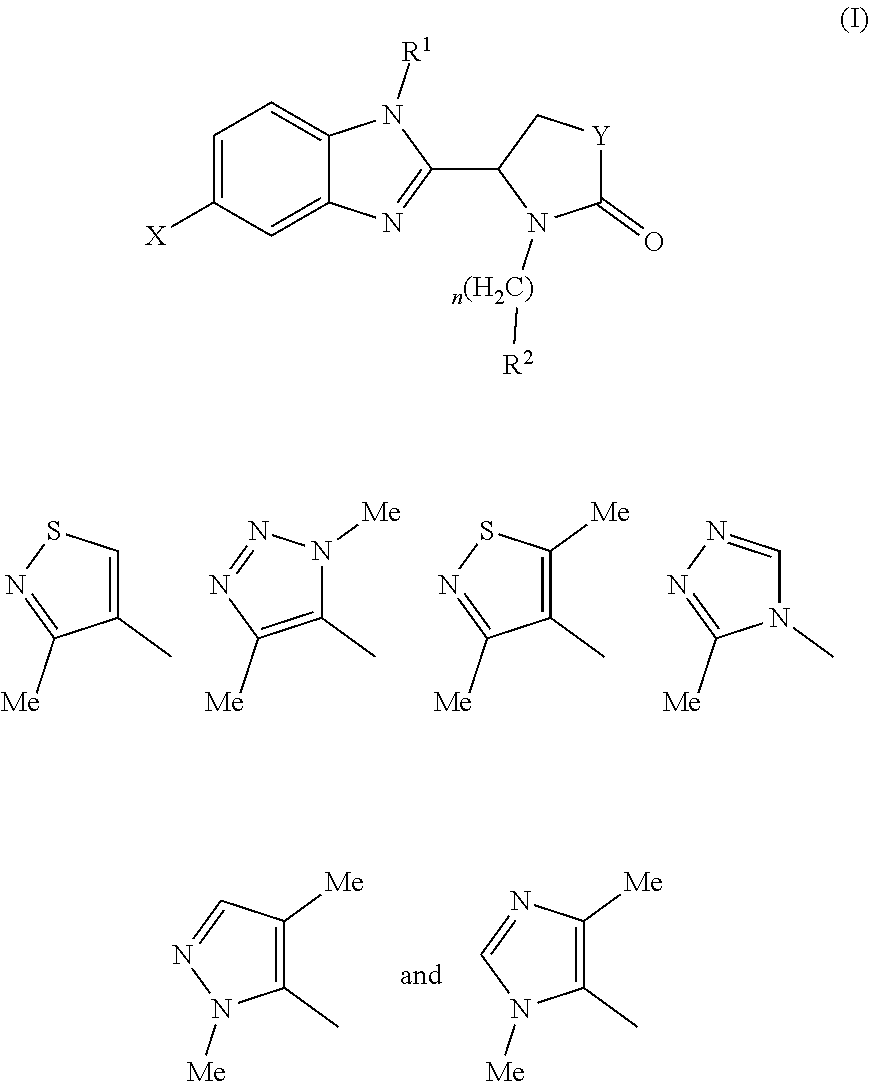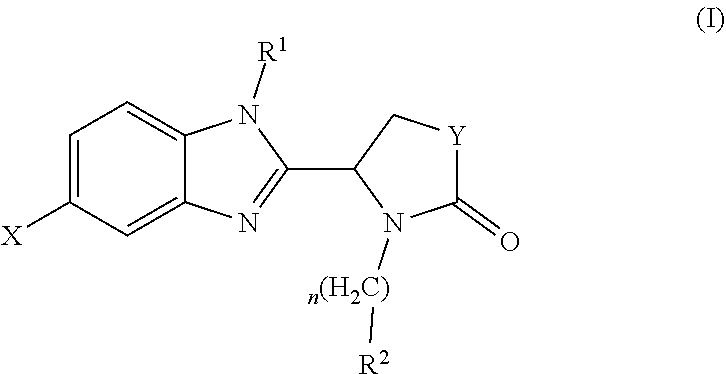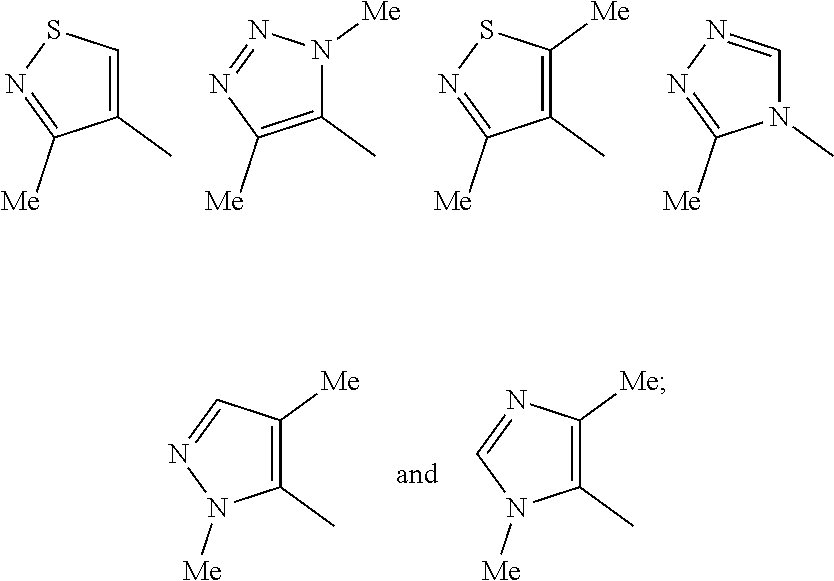Pharmaceutical compounds
a technology of benzimidazole and compound, applied in the field of benzimidazole, can solve the problems of limited clinical efficacy and prolong the progression of the disease, and achieve the effect of potent utility in the treatment of cancer
- Summary
- Abstract
- Description
- Claims
- Application Information
AI Technical Summary
Benefits of technology
Problems solved by technology
Method used
Image
Examples
example 1
(1S,4r)-4-(2-((S)-1-(3,4-difluorophenyl)-5-oxopyrrolidin-2-yl)-5-(1,4-dimethyl-1H-1,2,3-triazol-5-yl)-1H-benzo[d]imidazol-1-yl)cyclohexyl Acetate
(S)-1-(3,4-difluorophenyl)-5-oxopyrrolidine-2-carboxylic Acid
[0125]
[0126]DBU (20 ml, 133 mmol) was added to a suspension of (S)-5-oxopyrrolidine-2-carboxylic acid (8.0 g, 62.0 mmol) in acetonitrile (15 mL) then stirred for 10 minutes at room temperature. CuTMEDA (1.5 g, 3.23 mmol) was added then the mixture was stirred for a further 10 minutes. (3,4-Difluorophenyl)boronic acid (10.0 g, 63.3 mmol) was added then the mixture was heated to 50° C. for 18 h. The residue was diluted with water (200 mL) then extracted with diethyl ether (2×200 mL). The aqueous layer was treated with 1 M aqueous hydrogen chloride (200 ml, 200 mmol) then extracted with ethyl acetate (3×200 mL). The combined organic phases were concentrated onto loose silica gel. The silicate was purified on a silica gel filter plug, eluting with EtOAc / dichloromethane (0-100%) to giv...
example 2
(S)-1-(3,4-difluorophenyl)-5-(5-(1,4-dimethyl-1H-1,2,3-triazol-5-yl)-1-((1r,4S)-4-hydroxycyclohexyl)-1H-benzo[d]imidazol-2-yl)pyrrolidin-2-one
[0137]
[0138](1 S,4r)-4-(2-((S)-1-(3,4-difluorophenyl)-5-oxopyrrolidin-2-yl)-5-(1,4-dimethyl-1H-1,2,3-triazol-5-yl)-1H-benzo[d]imidazol-1-yl)cyclohexyl acetate (27 mg, 0.049 mmol) was diluted in MeOH (1991 μl, 49.2 mmol). Potassium carbonate (20.41 mg, 0.148 mmol) was added and the suspension was stirred at RT for 2 h. The reaction mixture was concentrated in vacuo, then the solid was dissolved in DCM (5 mL), sonicated and dry loaded on silica gel. The crude product was purified by flash chromatography on silica gel (12 g column, 0-10% MeOH / DCM) to afford (S)-1-(3,4-difluorophenyl)-5-(5-(1,4-dimethyl-1H-1,2,3-triazol-5-yl)-1-((1r,4S)-4-hydroxycyclohexyl)-1H-benzo[d]imidazol-2-yl)pyrrolidin-2-one (20 mg, 79%) as a colourless solid; Rt 1.52 min (method 1), m / z 507; 1H NMR (d6-DMSO) δ: 7.90 (d, J=8.5 Hz, 1H), 7.86-7.76 (m, 1H), 7.74-7.67 (m, 1H), ...
example 3
(S)-5-(1-(4,4-difluorocyclohexyl)-5-(1,4-dimethyl-1H-1,2,3-triazol-5-yl)-1H-benzo[d]imidazol-2-yl)-1-(3,4-difluorophenyl)pyrrolidin-2-one
4-Bromo-N-(4,4-difluorocyclohexyl)-2-nitroaniline
[0139]
[0140]4-Bromo-1-fluoro-2-nitrobenzene (1.90 mL, 15.44 mmol), 4,4-difluorocyclohexanamine hydrochloride (2.65 g, 15.44 mmol) and potassium carbonate (5.34 g, 38.6 mmol) were heated to reflux (82° C.) in acetonitrile (46.8 ml, 896 mmol) for 4.5 h. The reaction was cooled down to RT and left over the week-end. The mixture was diluted with water (200 mL) then the orange precipitate was collected by filtration. The crude product (5.8 g wet orange solid) was purified by chromatography on the Companion (80 g column, 0-100% EtOAc / DCM) to afford 4-bromo-N-(4,4-difluorocyclohexyl)-2-nitroaniline (4.33 g, 82%) was obtained as an orange solid; Rt 1.99 min (method 2); m / z 381 (M+H)+(ES+).
4-Bromo-N1-(4,4-difluorocyclohexyl)benzene-1,2-diamine
[0141]
[0142]Sodium dithionite (26.6 g, 129 mmol) was added to a mix...
PUM
| Property | Measurement | Unit |
|---|---|---|
| variable wavelength detector | aaaaa | aaaaa |
| variable wavelength detector | aaaaa | aaaaa |
| variable wavelength detector | aaaaa | aaaaa |
Abstract
Description
Claims
Application Information
 Login to View More
Login to View More - R&D
- Intellectual Property
- Life Sciences
- Materials
- Tech Scout
- Unparalleled Data Quality
- Higher Quality Content
- 60% Fewer Hallucinations
Browse by: Latest US Patents, China's latest patents, Technical Efficacy Thesaurus, Application Domain, Technology Topic, Popular Technical Reports.
© 2025 PatSnap. All rights reserved.Legal|Privacy policy|Modern Slavery Act Transparency Statement|Sitemap|About US| Contact US: help@patsnap.com



